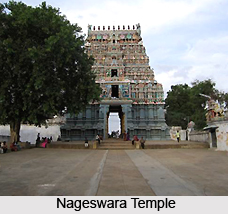 Nageswara Temple is known for its sculptures, vimanas and mandapas. Some legends are also attached to this temple. As per legend Lord Surya is believed to have worshipped Lord Shiva in order to get back his lost brilliance. The temple tank is named after Lord Surya. It is also known as "Vilvavanam" as it is believed that a Vilva leaf from the pot carrying the celestial nectar had drifted away and landed here. It is believed that Aadi Seshan worshipped here and Lord Shiva blessed him with the might to bear the weight of the earth.
Nageswara Temple is known for its sculptures, vimanas and mandapas. Some legends are also attached to this temple. As per legend Lord Surya is believed to have worshipped Lord Shiva in order to get back his lost brilliance. The temple tank is named after Lord Surya. It is also known as "Vilvavanam" as it is believed that a Vilva leaf from the pot carrying the celestial nectar had drifted away and landed here. It is believed that Aadi Seshan worshipped here and Lord Shiva blessed him with the might to bear the weight of the earth.
It is considered as the oldest in Kumbakonam and is one of the finest early Chola temples. This temple is believed to have been completed during the reign of Parantaka I. This temple is known for its marvellous architecture. The Nritta Sabha has an elevated Mandapam with a flight of steps. The 12 zodiac signs, 2 mammoth horses, 4 elephants adorn the shrine of Nataraja.
The principal shrine of Lord Shiva is connected to a Mandapa. The sanctum wall contain sculptures; on the north, "Dakshinamurti", on the west Ardhanarishvara and Brahma on the south. There are high-relief near-life-size sculptures of unidentified figures. The shrine to Nataraja in the courtyard features rearing horses and wheels, with tiny figures as spokes. The Nataraja shrine is shaped in the form of a chariot. The shrine dedicated to the Sun God is of sculptural significance. The Sun`s rays fall on Nageswara in the sanctum on the 11th through the 13th day of the Tamil month Chithirai. Lord Shiva is also known as "Paataala Beejanathar". There are other shrines that are dedicated to Pralayakaala Rudrar and Kaali.
There are figures of wealthy patrons of the temple. A Brahma and Ardhanariswara are found on the other side of the outer wall. An image of Goddess Durga is housed in a separate shrine here. In order to see the shrine of Nataraja and Sivakami one has to climb steps. Here Lord Siva is shown dancing vigorously and Sivakami is shown keeping tala for his cosmic dance.





















